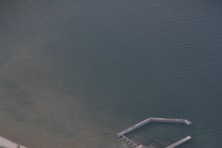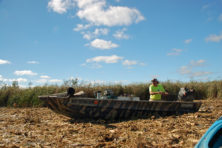Pilot Project for Beach Warning Lights Heading to County Board
- Share
- Tweet
- Pin
- Share

The Door County Board of Supervisors will consider funding for electronic beach warning signs that can be operated remotely to alert beachgoers when levels of bacteria in the water make it unsafe for swimming.
The request heading to the supervisors’ Jan. 24 meeting is for $40,000 in American Rescue Plan Act (ARPA) dollars that have been earmarked for environmental initiatives. The money would pay for five pilot signs ($6,000 each), plus an annual fee of $400 for each site.
Each summer, University of Wisconsin-Oshkosh students test Door County beach water for E.coli contamination at an average of 25 area beaches. Lab results aren’t ready until a day later, and if a closure or advisory is warranted, a student must travel to the beach to change the sign and then return to change it back.
The five pilot beaches are Otumba within the City of Sturgeon Bay, the beaches at the Village of Egg Harbor and the Village of Sister Bay, Frank E. Murphy County Park in the Town of Egg Harbor, and Baileys Harbor Ridges County Park.
Ken Pabich, Door County administrator, said during the Jan. 12 Land Conservation Committee meeting when the recommended funding was unanimously approved that the county is working with the two villages and the city to provide the cost of the power and annual maintenance. The signs must be ordered now to be in place for the 2023 summer season, Pabich said.
Eventually, the rapid-notification system can also be used to warn of physical conditions such as rip currents and offshore weather.
CAFO and County of Door versus State Authority
With a hearing coming up on a dairy expansion within the Town of Forestville, the County of Door corporation counsel, Sean Donohue, attended the County of Door’s Jan. 12 Land Conservation Committee meeting to explain the county’s role in a concentrated animal feedlot operation (CAFO).
He also needed to learn whether a quorum of committee members would be attending the Feb. 13 Department of Natural Resources (DNR) public hearing on S&S Jerseyland Dairy’s request to expand from 7,654 animal units to 14,711 (see the story in today’s paper, “Challenges Planned to Dairy Expansion”).
The county has an ordinance on the books that governs agricultural performance standards and animal-waste storage, but it cannot be more restrictive than what the state already has on the books, and neither does it apply to a CAFO, Donohue said.
A CAFO is an operation that has 1,000 animal units or more. When it hits that threshold, it becomes regulated by the DNR rather than the county.
If a producer rents rather than owns land, the county can regulate the owners of the land under the ordinance, ensuring that best practices are being followed on the rented land.
“That’s really the extent,” Donohue said. “Otherwise, it’s the exclusive jurisdiction of the DNR.”
The state regulates CAFOs under the Federal Clean Water Act to ensure that large operations have water-quality protection permits. The DNR may designate a smaller-scale animal feeding operation (fewer than 1,000 animal units) as a CAFO if it has pollutant discharges to navigable waters or contaminates a well.



